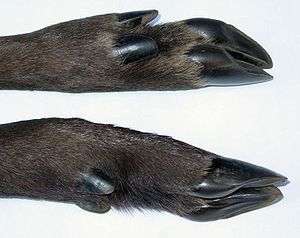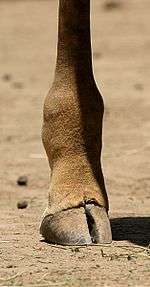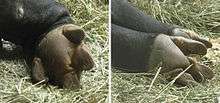Hoof

A hoof (/ˈhuːf/ or /ˈhʊf/), plural hooves (/ˈhuːvz/ or /ˈhʊvz/) or hoofs /ˈhʊfs/, is the tip of a toe of an ungulate mammal, strengthened by a thick, horny, keratin covering. Hooves is the plural form of hoof, it is the horny covering that is protecting the ends of the digits or limbs of certain animals such as the ox and horse.[1]
Structure
Within the hoof of an ungulate there are four layers within th e exterior wall of the hoof. From the outside, a hoof is made up of the stratum externum, the stratum medium, the stratum internum and the dermis parietis.[2] The stratum externum and the stratum medium are difficult to distinguish between, however the stratum externum is thin and the stratum medium is what makes up the bulk of the hoof wall.[2]
Inside the hoof wall is a laminar junction, a soft tissue structure. This soft tissue structure provides an animal to cope with the demands of force transmission it undergoes.[3] This tissue structure binds the inner surface of the hoof wall, the dermis parietis and the outer surface of the third phalanx.[3]
Contained within the tissue of the hoof, is the distal end of the second phalanx, the distal phalanx, and the navicular bone.[4] The positon that the navicular bone holds, makes the region of the hoof susceptible to a wide range of biomechanical actions.
Knowing the histology of the hoof, is it easier to comprehend how the hoof bears weight using the epidermal structures; these structures are the hoof wall, the bars of the hoof, the sole and frog and the soft tissue shock absorption structures.[4]
Description
The hoof consists of a hard or rubbery sole and a hard wall formed by a thick nail rolled around the tip of the toe. The weight of the animal is normally borne by both the sole and the edge of the hoof wall. Hooves grow continuously, and are constantly worn down by use. Hooves can be worn down by use, however in systems like the dairy and ovine and equine industry, hooves may be required to be trimmed by a farrier. Appropriate hoof trimming is essential to prevent lameness.[5] Lameness, behind infertility and mastitism is the biggest cause of economic loss to a dairy farmer.[6] Many farmers and veterinarians have used a phase that distinguished that if the animal has bad hooves then it is of no use, the most common version of this phrase is used with equine, "No hoof no horse."
Classification
Most even-toed ungulates (such as sheep, goats, deer, cattle, bison and pigs) have two main hooves on each foot, together called a cloven hoof.[Note 1] Most of these cloven-hoofed animals also have two smaller hoofs called dewclaws a little further up the leg – these are not normally used for walking, but in some species with larger dewclaws (such as deer and pigs) they may touch the ground when running or jumping, or if the ground is soft. In the mountain goat, the dewclaw serves to provide extra traction when descending rocky slopes as well as additional drag on loose or slippery surfaces made of ice, dirt, or snow.[7] Other cloven-hoofed animals (such as giraffes and pronghorns) have no dewclaws.
In some so-called "cloven-hoofed" animals, such as camels, the "hoof" is not properly a hoof – it is not a hard or rubbery sole and a hard wall formed by a thick nail – instead it is a soft toe with little more than a nail merely having an appearance of a hoof.
Some odd-toed ungulates (equids) have one hoof on each foot; others have (or had) three distinct hoofed or heavily nailed toes, or one hoof and two dewclaws. The tapir is a special case, having three toes on each hind foot and four toes on each front foot.
Another way to distinguish ungulates is by the form of their hooves. Artiodactyls are even-toed ungulates, meaning that these species have an even number of digits on each foot.[8] Ruminants , with two main digits, are the largest group of representatives of the classification artiodactyls.[8] Examples of artiodactyls would be deer, bison, cattle, goats and sheep.[8] The other classification is perissodactyla. These are hoofed mammals that have an odd number of toes.[9] Examples of perissodactyl mammals would be horses, rhinoceroses and tapirs.[9]
Care
Although in nature, wild animals are capable of wearing down the hoof as it continuously grows, some domesticated species must undergo specific hoof care. Proper hoof trimming and care promotes a healthy, functional hoof and biomechanical efficiency and prevents lameness.[10] Hoof care and trimming is most well known with the equine industry. The equine hoof is a unique structure that follows the laws of physics.[10] There are numerous functions to hooves; these functions would include supporting weight of the animal, dissipating the energy impact as the hooves strike the ground or surface, protection of the fragile tissues and bone within the hoof capsule, as well as provides traction for the animal.[10] When the hard exterior of the hoof undergo care such as trimming or even shoeing, it affects the external hoof capsule as well as the internal structures.[10]
Numerous factors can affect hoof structure and health. The genetics, breed, hoof conformation, environmental influences, and athletic performance of the animal.[10] The ideal hoof has a parallel hoof-pastern axis, a thick hoof wall, adequate sole depth, a solid heal base and growth rings of equal size under the coronary band.[10]
Common Problems
Equine
Horses are an animal that requires heavy maintenance on their hooves in order to keep them healthy and in good working order. There are numerous hoof problems that occur in horses (sometimes seen in other animals as well), following these maintenance techniques should prevent health issues
1. regular trimming and shoeing
2. maintaining good hoof balance
3. maintaining the correct hoof pastern angle, break over, and medial-lateral balance
4. having heel support
5. use of appropriate shoeing for weather and footing conditions
6. use appropriate treatment if disease process occurs
Problems that can arise with poor hoof health of numerous ungulates are hoof cracks, thrush, abcesses and laminitis.[11]

 Rear foot of a giraffe (no dewclaws)
Rear foot of a giraffe (no dewclaws) Rear hooves of a horse
Rear hooves of a horse Camel hoof
Camel hoof Malayan tapir hooves: front with four toes, back with three toes
Malayan tapir hooves: front with four toes, back with three toes
Uses
Hooves have historical significance in ceremonies and games. They have been used in burial ceremonies.[12]
Hooves have also been used in the manufacture of high-end glues.
See also
Notes
- ↑ The term "cloven hoof" therefore being a technical misnomer as nothing is actually "cloven".
References
| Wikimedia Commons has media related to Hooves. |
- ↑ "the definition of hoof". Dictionary.com. Retrieved 2016-11-30.
- 1 2 Goulet, Catherine; Olive, Julien; Rossier, Yves; Beauchamp, Guy (2015-11-01). "RADIOGRAPHIC AND ANATOMIC CHARACTERISTICS OF DORSAL HOOF WALL LAYERS IN NONlAMINITIC HORSES". Veterinary Radiology & Ultrasound. 56 (6): 589–594. doi:10.1111/vru.12280. ISSN 1740-8261.
- 1 2 "http://www.karger.com/Article/FullText/16744". www.karger.com. Retrieved 2016-11-30. External link in
|title=(help) - 1 2 "Basic Farriery for the Performance Horse". www.sciencedirect.com. Retrieved 2016-11-30.
- ↑ Aoki, Yasuhiro (2006). [Hooves can be worn down by use, however in systems like the dairy and ovine and equine industry, hooves may be required to be trimmed by a farrier. Appropriate hoof trimming is essential to prevent lameness (Aoki, Y. et al., 2006). Lameness, behind infertility and mastitism is the biggest cause of economic loss to a dairy farmer (Weaver, A., 2006). Many farmers and veterinarians have used a phase that distinguished that if the animal has bad hooves then it is of no use, the most common version of this phrase is used with equine, "No hoof no horse." "Changes in walking parameters of milking cows after hoof trimming"] Check
|url=value (help). Animal Science Journal. 77: 103–109 – via Wiley Online Library. - ↑ Weaver, A. D. (1985-01-01). "Lameness in cattle—Investigational and diagnostic check lists". British Veterinary Journal. 141 (1): 27–33. doi:10.1016/0007-1935(85)90123-X.
- ↑ A Beast the Color of Winter: The Mountain Goat Observed. U of Nebraska Press. 1 February 2002. p. 52. ISBN 0-8032-6421-6.
- 1 2 3 Keller, Anna; Clauss, Marcus; Muggli, Evelyne; Nuss, Karl (2009-07-15). "Even-toed but uneven in length: the digits of artiodactyls". Zoology. 112 (4): 270–278. doi:10.1016/j.zool.2008.11.001.
- 1 2 Holbrook, Luke T. (1999-09-01). "The Phylogeny and Classification of Tapiromorph Perissodactyls (Mammalia)". Cladistics. 15 (3): 331–350. doi:10.1111/j.1096-0031.1999.tb00270.x. ISSN 1096-0031.
- 1 2 3 4 5 6 "Elsevier: Article Locator". www.sciencedirect.com. Retrieved 2016-11-30.
- ↑ "Common hoof problems : Horse : University of Minnesota Extension". www.extension.umn.edu. Retrieved 2016-11-30.
- ↑ M. E. Robertson-Mackay (1980). "A head and hooves burial beneath a round barrow, with other Neolithic and Bronze Age sites on Hemp Knoll, near Avebury, Wiltshire". Proceedings of the Prehistoric Society.